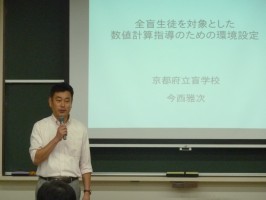
- 福永裕輝(京都教育大学大学院)・西浦誠人(京都教育大学附属桃山中学校)・黒田恭史(京都教育大学)
「濃度の数学的特徴理解を踏まえた教育実践 2層に分かれる現象実験を用いて」
- 青木駿介(京都教育大学)・岡本尚子(立命館大学)黒田恭史(京都教育大学)
「立方体の切断課題解決時における視線移動の特徴 視線移動計測実験の結果を通して」

- 木下卓海(京都教育大学大学院)・岡本尚子(立命館大学)・黒田恭史(京都教育大学)
「立体図形問題遂行時における学習者の思考過程の分析-視線移動計測を通して-」
- 牟田口輝一・黒田恭史(京都教育大学)
「日本語指導を要する児童生徒の算数・数学教育の学習をサポートする多言語動画コンテンツの開発・実践」
- 菊池翔太(京都教育大学)・西浦誠人(京都教育大学附属桃山中学校)・黒田恭史(京都教育大学)
「GeoGebraを用いた中学校数学の図形移動に関する教育実践-生徒による図形の動的な操作活動の導入-」
- 小西爽生・黒田恭史(京都教育大学)
「Excelを用いた高等学校数学B数列に関する教育実践-高校生を対象とした認識調査から-」









日程:2018年8月27日(月) 15時00分~
会場:本学A棟4階 1A402教室
[1] 15:00~15:30 Makoto Okumura(Graduate School of Osaka University)
Title: A linear and structure-preserving scheme for a conservative Allen–Cahn equation with a time-dependent Lagrange multiplier
Abstract: We propose a linear and structure-preserving scheme for a non-local conservative Allen–Cahn equation introduced by Rubinstein and Sternberg (1992) based on a combination of the discrete variational derivative method (DVDM) and a linearization technique. DVDM is a numerical method proposed by Furihata (2010). DVDM schemes inherit conservative or dissipative properties from the original PDEs in a discrete sense. By this approach, we obtain a nonlinear scheme in general. Then, we need some iterative solver to solve the system. This means that the computational cost is expensive. Therefore, we also use a linearization technique. The basic idea of our linearization technique is the decompositions of nonlinear terms by introducing extra time steps of numerical schemes. We expect that the proposed linear scheme is faster than the nonlinear one. In this talk, we show the stability, the existence and uniqueness of the solution for the proposed scheme, and the error estimate. We also show numerical experiments.
15:30~15:40 Coffee Break
[2] 15:40~16:30 Hao Wu(School of Mathematical Sciences, Fudan University)
Title: An introduction on the Energetic Variational Approach and its applications
Abstract: In this talk, we will discuss the Energetic Variational Approach for modelling complex physical systems. This approach is based on a balance between the maximal dissipation principle and the least action principle. As a consequence, it naturally keeps the physical laws, such as the conservation of mass, energy dissipation and force balance. Then we will show its application to some well-known systems, for instance, the Cahn–Hilliard equation etc.
[3] 16:30~ Free Discussion

















